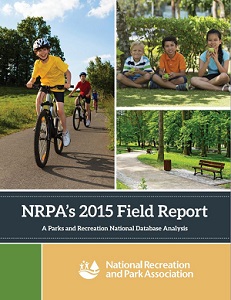You probably already know that PRORAGIS is a powerful tool to help you compare your agency to others on many measures. You may even know that each year, NRPA takes a look at all the data that is in PRORAGIS and provides an analysis of how the field is doing as whole.
How’d we do with our budgets and staffing?
How’d we do with operations and maintenance?
How’d we do with programming and attendance?
 The answers are all in the NRPA Field Report – A Parks and Recreation National Database Analysis.
The answers are all in the NRPA Field Report – A Parks and Recreation National Database Analysis.
As you look at all this collective data, you can start to see trends. One of the most important things to be aware of is the trends facing parks and recreation. Why? Because we have to understand where we are going and what may have an impact on our roles and future to prepare for those influences and stay relevant.
As part of our annual analysis of the data in PRORAGIS, we identified five trends that will impact the future of parks and recreation.
Trend 1: Programs are key to great park attendance.
The public likes programs in parks. When there are programs in parks attendance is stronger. When you don’t have programs in parks it can lead to a slew of consequences – less use, less public support, reduced budgets and more. One caution – watch out for those mandates on cost recovery and the unintended social inequity that could be a result.
Trend 2: The perceived value of distributed services results in agency functions assigned to various departments.
The recession resulted in a lot of restructuring of departments and shifting roles. One thing is for certain, when a single department carries out all the park and recreation responsibilities, operations are most effective. If your agency can position itself as a valuable essential service and optimize your services, you’ll fare best.
Trend 3: Agencies are pioneering new funding methods.
We have to remember that the “new normal” of shrinking municipal budgets doesn’t necessarily mean there is less public support or demand. Getting creative to maximize this demand and bolster your revenue can be critical. In fact, during the recession those agencies and special districts that invested in revenue-producing facilities fared better than others. Keep in mind that you’ll want to retain revenues for agency operations for success. The Analysis report has a few examples.
Trend 4: Infrastructure deficit means you’ll have to fight harder for public dollars.
The nation’s infrastructure of state roads, highways, bridges, dams, sewers and more are well over-due for replacement, renovation or renewal. Funding for these projects will compete with yours. But you can address this – be at the infrastructure table to discuss park needs and how you provide innovative solutions to the infrastructure challenge.
Trend 5: Walkable cities draw Millennials, fueling a suburban exodus. 
The Millennials are here and have moved into the center of influence with their distinct views and behaviors. Research shows they are drawn to walkable environments with cultural amenities. Not only do you have to think about how you can serve their interests and harness their influential power, but we have to consider the shifts that are happening in our urban cores. Will disadvantaged populations be pushed into the suburbs? What does that mean for the services we provide?
The NRPA 2015 Field Report – A Parks and Recreation National Database Analysis has all of the trends and the data you need to understand the current landscape of our field and where we are going. Not only that, to honor NRPA's 50th Anniversary, the report takes a look back on a half-century of prioritizing data with fascinating results.
Which trends do you think will have the most impact on the field? How will you prepare for them? Leave a comment below or tweet us @NRPA_News.
Lauren Hoffmann is NRPA's director of marketing and communications.

